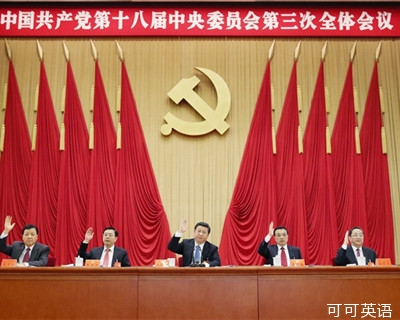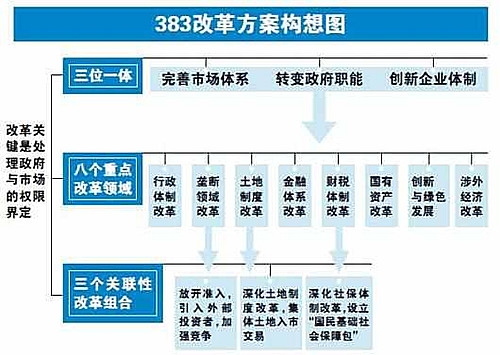(单词翻译:单击)
公报 Communique
回顾以往历次三中全会,一般都会审议通过一份“决定”,会后有时还会发布“公报”。
十八届三中全会于11月12日闭幕并发布全会公报,中国未来十年改革路线图随之揭晓。回顾以往历次三中全会,一般都会审议通过一份“决定”,会后有时还会发布“公报”。那么,全会通过的“决定”、“公报”等文件有什么区别呢?
《党政机关公文处理条例》指出,“公报”(Communique)适用于“公布重要决定或者重大事项”,如,《中国共产党第十八届中央委员会第三次全体会议公报》(Communique of the Third Plenum of 18th CPC Central Committee)。
“决定”(Decision)适用于“对重要事项作出决策和部署、奖惩有关单位和人员、变更或者撤销下级机关不适当的决定事项”,如,《中共中央关于全面深化改革若干重大问题的决定》(The Decision of the CPC Central Committee on Several Important Issues of Comprehensively Deepening Reform)。

“决议”(Resolution)适用于“会议讨论通过的重大决策事项”,如,《中国共产党第十八次全国代表大会关于十七届中央委员会报告的决议》(Resolution of the Eighteenth National Congress of the Communist Party of China on the Report of its Seventeenth Central Committee)。
“报告”(Report)适用于“向上级机关汇报工作、反映情况,回复上级机关的询问”,如,《政府工作报告》(Report on the Work of the Government)。
“意见”(Opinion)适用于“对重要问题提出见解和处理办法”,如,《关于地方政府职能转变和机构改革的意见》(Opinion on Functional Transformation and Institutional Reform of Local Governments)。
政府改革 government reform
如果说中央政府改革是上篇,地方政府改革就是下篇,需要整体构思、通盘考虑、上下贯通。
国务院总理李克强在日前召开的地方政府职能转变和机构改革工作电视电话会议上指出,如果说中央政府改革是上篇,地方政府改革就是下篇,需要整体构思、通盘考虑、上下贯通,把政府改革的整篇文章做好。
李克强指出,政府改革(government reform)的主要目的,就是进一步理顺政府和市场、政府和社会、中央和地方的关系(to clearly define the relations between government and the market, between government and society and between central and local governments),更好地发挥市场、社会的作用,更好地调动中央和地方两个积极性,推动政府全面正确地履行职能(make sure that the government fully plays its part),加快现代政府建设(to accelerate the development of modern government),努力促进经济持续健康发展、社会不断进步,不断满足人民群众的新期待、新要求。
在提到地方政府职能转变(the transformation of local government functions)时,李克强讲到以下几点:
1. 要接好放好中央下放的审批事项(Local governments should properly take over or further release as required approval power delegated by the central government);
2. 要最大限度地取消地方行政审批事项(We should minimize the number of items subject to administrative review and approval by local governments);
3. 要加强地方政府管理服务职能(Local governments need to enhance their functions in both regulation and services);
4. 改革创新监管方式,建立一套科学监管的规则和方法(We also need to reform and innovate ways of supervision and establish a set of scientific rules and methods of supervision);
5. 搞好保障民生的基本公共服务(To ensure basic public services essential to people's livelihood);
6. 要更加重视基层政府建设(We need to place greater importance on the building of community-level governments)。
讲到地方机构改革(local institutional reform)时,李克强指出,这次地方政府机构改革,要着力搞好“控、调、改”。
1. 要严控机构编制总量(The size of government staffing must be put under rigorous control);
2. 要调整优化机构编制结构(The organization and staffing structure of government agencies should be adjusted and improved);
3. 要通过深化改革满足事业发展的需要(Reform should be deepened to meet our needs for development)。
产权多元化 ownership diversification
在全会结束后,将对国企进行改革。当前的改革方向是推进产权多元化,鼓励私企入股国企。
The restructuring and upgrading of State-owned enterprises is at a crucial stage, and Huang said further ownership diversification is "a high priority" that will benefit sustainable development of the Chinese economy.
国资委副主任黄淑和说,国有企业的重组改制和优化升级正处于关键阶段,进一步推进产权多元化是优先发展的重点方向,这将有益于中国经济的可持续发展。
“产权多元化”就是ownership diversification,是国企未来的发展趋势。其中一个途径就是injecting private capital into State-owned assets(私企向国企注入资金)。
当前State-owned enterprises(SOE,国企)和central SOEs(央企)正处于restructuring and upgrading(重组改制和优化升级)的关键时期,推行diversified ownership(混合所有制)有利于中国经济的sustainable development(可持续发展)。
群众路线 mass line
群众路线(mass line)就是一切为了群众,一切依靠群众,从群众中来,到群众中去。
党的群众路线教育实践活动工作会议6月18日在北京召开,中共中央总书记、国家主席、中央军委主席习近平出席会议并发表重要讲话,对全党开展教育实践活动进行部署。
请看《中国日报》的报道:
Xi, general secretary of the CPC Central Committee, urged its members to adopt the "mass line" as they did during revolutionary times, in a move to improve ties with the public.
中共中央总书记习近平要求全体党员像在革命时期一样走“群众路线”,密切党群关系。
群众路线(mass line)就是一切为了群众,一切依靠群众,从群众中来,到群众中去(doing everything for the masses, relying on them in every task, carrying out the principle of “from the masses, to the masses”)。
习近平指出,目前党内脱离群众现象集中表现在形式主义(formalism)、官僚主义(bureaucratism)、享乐主义(hedonism)和奢靡之风(extravagance)这“四风”上。
此次讲话要点还包括:
1. 人心向背关系党的生死存亡。
Winning or losing public support is an issue that concerns the CPC's survival or extinction.
2. 党只有始终与人民心连心、同呼吸、共命运,始终依靠人民推动历史前进,才能做到坚如磐石。
The CPC can only be stable when it dedicates its soul and mind to the people, and relies on the people to push forward historical advancement.
3. 照镜子、正衣冠、洗洗澡、治治病
Watch from the mirror, groom oneself, take a bath and seek remedies
全面深化改革 comprehensively deepening reform
为期四天的十八届三中全会将对全面深化改革作总体部署。
十八届三中全会于11月9日开幕,全面深化改革的蓝图即将展开。党的十八大提出全面深化改革,十八届三中全会将再次果敢抉择,指引改革的方向。
“Comprehensively deepening reform” means the reform will be more systematic, integrated and coordinated. The CPC will work to speed up the development of a socialist market economy, democracy, cultural development, social harmony and ecological progress.
“全面深化改革”意味着改革将更加注重系统性、整体性、协同性。中国共产党将加快发展社会主义市场经济、民主政治、先进文化、和谐社会和生态文明。
为期四天的十八届三中全会将对全面深化改革(comprehensively deepening reform)作总体部署。中共中央政治局常委、全国政协主席俞正声在会前表示,这一轮改革范围之广,力度之大,都将是空前的。全面深化改革可能涉及的领域有:投融资体制改革(reform of the investment and financing circulation system)、行政体制改革(reform of the administrative system)、财税制度改革(reform of fiscal revenue and tax distribution system)、金融体制改革(reform of the financial system)、农业工作改革(agricultural reform)、民生领域改革(reform concerning people’s livelihood)、外贸体制改革(reform of foreign trade system)、城镇化改革(urbanization reform)、产业政策改革(reform of industry policies)以及服务业改革(reform of the service industry)。
其中,简政放权(government streamlining)、收入分配制度改革(reform of income distribution system),以及户口制度改革(reform of the household registration system)等均受到各界的广泛关注。同时,外媒报道多数预测金融体制改革(reform of the financial system)将是本次全会的重要议题。
投融资体制改革(reform of the investment and financing circulation system)主要涉及推动民间资本有效进入金 融、能源、铁路、电信等领域,同时提出“尝试由民间资本发起设立自担风险的民营银行”。
行政体制改革(reform of the administrative system)主要涉及简政放权,转变职能,创新管理,以及加强政府信息公开回应社会关切提升政府公信力。2013年3月至11月 共取消下放334项行政审批等事项。
财税制度改革(reform of fiscal revenue and tax distribution system)涉及进一步扩大营业税(business tax)改增值税(value-added tas)试点范围,暂免征收部分小微企业增值税和营业税。
金融体制改革(reform of the financial system)涉及全面放开贷款利率管制,进一步扩大信贷资产证券化试点。2013年9月中国(上海)自由贸易试验区正式挂牌成立,自贸区内金融试点包括:利率市场化、汇率自由汇兑、金融业的对外开放、产品创新等,也涉及一些离岸业务。
农业工作改革(agricultural reform)涉及现代农业综合配套改革试验,选择有条件的地方率先开展现代农业综合配套改革试验。
民生领域改革(reform concerning people’s livelihood)涉及高校毕业生就业、奶粉安全、大气污染防治、以及收入分配制度改革等。
外贸体制改革(reform of foreign trade system)涉及加大出口退税支持力度,加快推进跨境贸易人民币结算,改善融资服务、扩大信用保险支持,以及完善人民币汇率形成机制等。
城镇化改革(urbanization reform)主要涉及全面放开小城镇和小城市落户限制,有序放开中等城市落户限制,逐步放宽大城市落户条件,合理设定特大城市落户条件,逐步把符合条件的农业转移人口转为城镇居民。
产业政策改革(reform of industry policies)涉及加快发展节能环保产业,促进信息消费,以及化解产能严重过剩矛盾等。
服务业改革(reform of the service industry)涉及大力发展医疗服务。加快发展健康养老服务。积极发展健康保险。全面发展中医药医疗保健服务,支持发展多样化健康服务。培育健康服务业相关支撑产业。健全人力资源保障机制。夯实健康服务业发展基础。
全能政府 omnipotent government
全能政府指政府在经济发展中同时扮演决策者、投资者、招商者、管理者、监督者等角色。
政府职能转变,预计将是以部署全面深化改革为主题的中共十八届三中全会的重要内容。不少专家认为,尽管政府职能转变取得了一定成效,但要由全能政府真正变为有限政府,还有很长的路要走。
请看相关报道:
Government omnipotence, which has become an obstacle to efficiency after powering China's staggering growth in past decades, is expected to be addressed in reforms outlined by the country's new leadership for the next decade.
中国新一届领导集体有望在未来十年通过改革解决全能型政府问题,全能型政府在过去几十年带动了中国高速增长,但现在已经成为影响经济高效发展的阻力。
Government omnipotence(全能型政府)也可以用omnipotent government表示,指政府在经济发展中同时扮演着决策者(decision-maker)、投资者(investor)、招商者(franchiser)、管理者(regulator)、监督者(supervisor)等等角色,各个领域都由政府主导,这种经济发展模式不可避免地带来了产能过剩(overcapacity)、环境污染(environmental pollution)、债务风险(debt crisis)、市场缺乏活力(market malfunctions)等问题。
目前这种政府主导的增长模式(government-led growth model)已经严重阻碍了中国的经济结构转型(economic restructuring)和市场经济进一步发展。
与之相对的有限政府(limited government)是指政府自身在规模(scale)、职能(functions)、权力(power)和行为方式(work style)上受到法律和社会的严格限制和有效制约。
近半年国务院取消和下放行政审批事项(administrative approval items)200多项,目前仍有约1500项,地方政府层面的审批项目则多达1.7万项。每项审批权力的削减,必然会消解一部分人的利益,能不能破除这些阻力,将考验改革的决心和意志(putting the reformers' determination and courage to the test)。
“383”方案 383 plan
"383 plan"指包含“三位一体改革思路、八个重点改革领域、三个关联性改革组合”的新一轮改革路线图。
日前,国务院发展研究中心(国研中心)首次向社会公开了其为十八届三中全会提交的“383”改革方案总报告全文,勾勒出一幅详尽的改革“路线图”。
The "383 plan" is named for its content: a "trinity reform" of market, government and enterprise, which will be spread across eight key areas, with three major breakthroughs to be made.
所谓“383”方案是指横跨八个领域涉及市场、政府以及企业的“三位一体改革”,并在三方面改革中取得重大突破。
"383 plan"就是最近大家都在讨论的“383”方案,是指包含“三位一体改革思路、八个重点改革领域、三个关联性改革组合”的中国新一轮改革路线图(reform roadmap)。其中,“三位一体改革”(trinity reform)指完善市场体系(improving the market system)、转变政府职能(transforming government functions)、创新企业体制(creating new business structures)三方面的综合改革;涉及的八个改革领域分别为管理体制(administrative system)、基础产业(basic industries)、土地制度(land system)、金融体系(financial system)、财税体系(fiscal revenue and tax distribution system)、国资管理(administration and management of State-owned assets)、激励创新(promotion of innovation)、以及涉外经济(foreign economy)。

三方面改革目标为:降低市场准入门槛以吸引投资者并鼓励竞争(lowering market entry barriers in order to attract investors and to foster competition); 为全体国民建立“国民基础社保包(setting up a basic social security package for citizens); 以及允许集体土地在统一市场交易( allowing collective land to be traded on a unified market)。
报告还给出了改革的“时间表(timetable)”,建议将改革分为三个阶段,即2013年至2014年的近期改革、2015年至2017年的中期改革和2018年至2020年的远期改革,以建立一个有活力、创新、包容、有秩序,及法制的社会主义市场经济(to establish an energetic, innovative, inclusive, orderly and rule-by-law socialist market economy)。
自上而下的改革 top-down reform
李克强所说的cutting one's own wrist(壮士断腕)指的就是政府自上而下的改革。
李克强总理曾在一次新闻发布会上,把政府削权比作“壮士断腕”,展示了他转变政府角色的决心。这种自上而下的改革有望在当前召开的十八届三中全会内容中得到体现。
请看新华社的报道:
At a press conference held in March right after the usher-in of the new leadership, Premier Li Keqiang compared reducing government power to "cutting one's own wrist" to demonstrate his resolve to transform government roles.
在三月份新领导班子进驻后不久举行的一次新闻发布会上,李克强总理将政府削权比喻成“壮士断腕”,以展示他转变政府角色的决心。
李克强总理所说的cutting one's own wrist(壮士断腕/自我断腕)指的就是政府的top-down reforms(自上而下的改革)。自从改革开放以来,国家在体制改革上已经取得了显著进展,但中国政府要成为一个de facto limited government(有限政府)还需要漫长的努力。
今年中央政府已经废弃了200多个administrative approval items(行政审批项目),这意味着一部分群体的利益将受到损害,这将考验改革者的决心和勇气。专家称,现阶段的改革实质上是carrying out reforms on the reformers themselves(对改革者自身的改革),关键在于mindset of the cadre team(干部队伍的心态)。
城镇化率 urbanization ratio
城镇化率(urbanization ratio)就是城镇人口(population in urban areas)占总人口(entire population)的比例。
根据国家统计局公布的数据,截至2012年年底,城镇化率已达52.57%。然而,这只是基于城镇常住人口的统计。在国家统计局第六次人口普查数据中,户籍城镇化率是27.7%。
请看相关报道:
China's urbanization ratio hit 52.57 percent in 2012, increasing almost 1 percentage point each year from 17.9 percent in 1978.
2012年,中国的城镇化率达到52.57%,几乎是从1978年的17.9%每年递增1个百分点。
城镇化率(urbanization ratio)就是城镇人口(population in urban areas)占总人口(entire population)的比例。基于城镇常住人口(resident population in urban areas)的统计来看,中国的城镇化率已超过50%;但是从户籍(household registration)角度来看,城镇化率仅为27.7%,超过3亿农民工(migrant workers)居住在城市里却没有城镇户口,因此不能享受到相应的居民福利(residential welfare)。目前中国城镇化进程中的主要障碍就是户籍制度(household registration/hukou system)。
国家发改委的一位研究人员指出,目前中国的城镇化表现出三个特点:工业化缓慢(slow industrialization)、土地城镇化迅速(fast land urbanization),以及重速度不重质量(prioritization of speed over quality)。
工作作风 work style
新一届中央领导集体提出八项要求包括精简会议、视察时减少交通管制,以及厉行节约等。
中共新一届中央领导集体履新以来,身体力行改进文风、会风,备受瞩目。这股“新风”也已从上自下波及开来,各级会议纷纷以实际行动落实文风、会风的改进,引发舆论关注。
请看《中国日报》报道:
Many provincial Party committees have created detailed policies to improve their working style, as required by the country's core leadership.
多省党委均已按照中央领导集体要求,制定出改进工作作风的详细政策。
Working style就是“工作作风”,新一届中央领导集体就改进工作作风提出八项要求,包括condense meetings(精简会议)、reduce traffic control during inspection tours(视察时减少交通管制),以及practice thrift(厉行节约)等。
随后,中央军委发布luxury dinner ban(豪华宴会禁令),明确指出,不安排宴请,不喝酒,不上高档菜肴。各省也纷纷效仿,出台规定,要求厉行节约,会议时不得摆放鲜花(displaying flowers),不得挂横幅(welcoming banners)等。
更多精品翻译素材,敬请关注可可英语。


